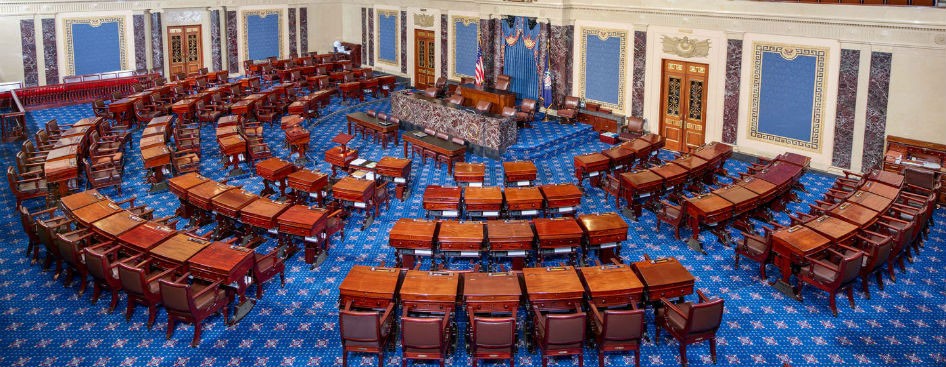News
Feinstein’s death raises the question: How are vacant Senate seats filled?

The possibility of other U.S. Senate vacancies looms, as well. (File photo by US Senate/Wikimedia Commons, Public Domain)
There’s an empty seat in the U.S. Senate now that California’s longtime and senior senator, Dianne Feinstein, has died.
And, following the Sept. 22, 2023, federal indictment on bribery and other charges of U.S. Sen. Bob Menendez, a Democrat from New Jersey, numerous people, including some prominent Democratic lawmakers, have called for Menendez to resign. Even Democratic New Jersey Gov. Phil Murphy, who would appoint a replacement for Menendez, has said the senator should step down.
So far, Menendez, who has pleaded not guilty to the charges, has refused to resign from the Senate.
The possibility of other U.S. Senate vacancies looms, as well. Following two on-camera episodes during summer 2023 when Sen. Mitch McConnell, a Republican, appeared temporarily unable to speak or move, some Republicans called for McConnell to resign.
McConnell has not indicated he plans to step aside.
The Conversation asked Gibbs Knotts, a professor of political science at the College of Charleston, to explain states’ processes for replacing U.S. senators who choose or are forced to vacate their seats, or who die while in office.
Who has the power in most states to temporarily or permanently replace US senators?
The basic rules about replacing U.S. senators are spelled out in the 17th Amendment of the U.S. Constitution: “When vacancies happen in the representation of any State in the Senate, the executive authority of such State shall issue writs of election to fill such vacancies: Provided, That the legislature of any State may empower the executive thereof to make temporary appointments until the people fill the vacancies by election as the legislature may direct.”
In simple terms, in 46 of the 50 states, governors have the power to make temporary appointments to fill U.S. Senate vacancies until either a scheduled or special election determines who will fill the remainder of a vacating senator’s term. That’s the case in California, where Gov. Gavin Newsom, a Democrat, will name Feinstein’s replacement. That person will serve until the next election for that seat, in November 2024.
Permanent replacements require an election. But there are rules about when and how these elections occur and those rules vary by state.
In 37 states, gubernatorial appointees serve the remainder of the term or until the next scheduled general election. In the remaining states with gubernatorial appointments, special elections are required, often with an accelerated timetable. For example, Alabama law requires a special election within 60 days of the gubernatorial appointment, while Massachusetts law calls for an election 145 to 160 days after the appointment.
North Dakota, Oregon, Rhode Island and Wisconsin do not allow governors to make temporary appointments. Those states only fill U.S. Senate vacancies by special election, but laws specify time periods in most states. For example, special elections in Wisconsin must take place between 62 and 77 days of the vacancy unless the opening occurs after July 1 during an even-numbered year. In this case the contest takes place during the November general election. However, there is not a time period specified by state law in Oregon.
How long do those appointments last?
If a person appointed to the seat by the governor then wins a special election or a contest scheduled alongside statewide elections, they will serve the remainder of the vacating senator’s term. Otherwise, if someone else wins the special election, they get to serve out the vacating senator’s term.
What rules are there on how governors make the appointments?
Governors have some restrictions on how they make U.S. Senate appointments. In 10 of the gubernatorial appointment states, U.S. senators must be from the same party as the prior incumbent. Arizona, Hawaii, Kentucky, Maryland, Montana, North Carolina, Oklahoma, Utah, West Virginia and Wyoming have this restriction.
In Utah, the governor is required to select from a list of three candidates submitted by the party of the U.S. senator being replaced.
In the rest of the states, the governor has the power to appoint a successor, regardless of party, including in California.
Do state legislators have a say in the process?
While governors have most of the power, state legislators also have a say in the process. Most notably, legislators establish the appointment procedures and set the general rules about when an election must occur. If they don’t like the process, they have the power to change it.
A recent example occurred in Oklahoma in 2021, which was then one of a very few states where a vacated Senate seat went unfilled until the next election.
Dissatisfied with that process, the Republican-controlled legislature passed a law to allow gubernatorial appointments for vacated U.S. Senate seats. Republican legislators were motivated to change their state’s law, in part, because of the 50-50 split in the U.S. Senate and a fear that a vacated seat would give an advantage to Democrats.![]()
Gibbs Knotts, Professor of Political Science, College of Charleston
This article is republished from The Conversation under a Creative Commons license. Read the original article.





















